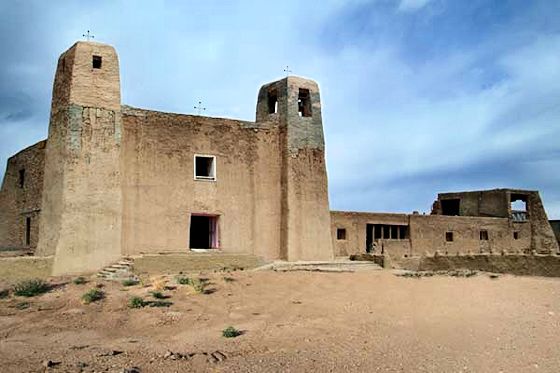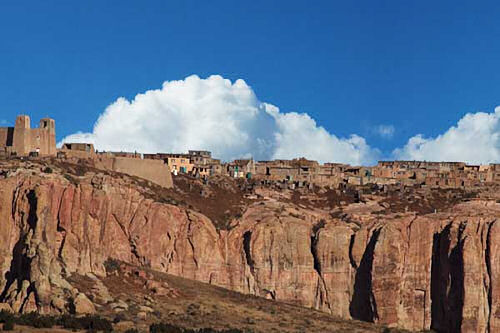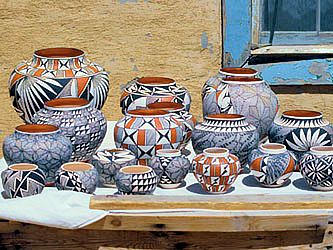The Acoma Indian Reservation is located in parts of Cibola, Socorro, and Catron counties in New Mexico, USA. This reservation covers 594.996 sq mi (1,541.033 km²). The Acoma Pueblo is the heart of the reservation and is the oldest continuously inhabited place in the United States.
A federally recognized Indian Tribe, Acoma Pueblo and the surrounding Acoma Indian Reservation has a land base covering 431,664 acres and is home to 4,800 tribal members with more than 250 dwellings, none of which have electricity, sewer, or water.

San Esteban del Rey Mission, built in 1629
In 1629, construction began on the massive San Esteban del Rey Mission, a Catholic mission. Spanish settlers built the San Esteban del Rey Mission in the Acoma Pueblo, carrying 30 foot beams 30 miles from Mount Taylor Mountain and the dirt for its graveyard up the mesa from the valley below.
At the time, the only access to the mesa was up the hand carved stairway in the cliff face. Both the Mission and the Pueblo are Registered National Historical Landmarks.
Acoma Pueblo was named the 28th National Trust for Historic Preservation (NTHP) site in 2007 and is the only Native American Historic Preservation site in the nation.
Acoma Pueblo is the population hub of this reservation.

Acoma Pueblo wide angle view of the mesa on top the sheer rock wall
Acoma Pueblo,also known as Sky City, is a Native American pueblo built on top of a 367-foot (112 m) sandstone mesa in a valley studded with sacred, towering monoliths.
Established in 1150, it is thought to be the oldest continuously inhabited community in the United States, along with the Hopi town of Old Oraibi, Arizona, as both communities were settled in the 11th century.
The Acoma people still speak a Keresan language (this language family is a linguistic isolate, commonly called Pueblo) which is still the first or only language of many older Acoma people. Although most middle aged and younger Acomans also speak English, it is not their first language. Many Acoma people also speak Spanish as a second or third language.
Access to the Acoma pueblo is difficult as the faces of the mesa are sheer. Before modern times, access was gained only by means of a hand-cut staircase carved into the sandstone.
Today, the Acoma Pueblo is made up of several villages, including Acomita, McCartys, Anzac and the newer subdivision of Sky Line. Acoma people dry-farm in the valley below Aa’ku and use irrigation canals in the villages closer to the Rio San Jose. Sheep, cattle, and grain are produced.

Examples of Acoma pottery
Many Acoma people are skilled potters and make their living selling pottery to the tourist trade. The tribe also operates the Skyline Casino.
The pueblo is open to the public only by guided tour. Photography of the pueblo and surrounding lands is restricted.
Tours can be arranged and $10 camera permits obtained from the recently renovated Sky City visitor center at the base of the mesa.
However, videotaping, drawing and sketching are prohibited, with big signs warning visitors not to do any of them (but especially not to videotape), and they are very serious about enforcing these rules. Get caught breaking them, and you will be fined and asked to leave.
The number of tribal members is about 6,000, with about 4,800 living on the reservation as of 2010. The Acoma Indian Reservation borders the Laguna Indian Reservation to the east, and is near El Malpais National Monument, which is due west. Acoma Pueblo is located 60 miles (100 km) west of Albuquerque, New Mexico on Interstate 40 and 12 miles (20 km) south on Indian Route 23.
Besides the Acoma Pueblo and surrounding communities, there are three Census Designated Places on the Acoma Indian Reservation.
They are Acomita Lake (a census designated place with 312 occupants), North Acomita Village, and Skyline-Ganipa.
Acomita Lake had 312 people, 74 households, and 60 families residing in the CDP as of the 2000 census. There were 74 households out of which 37.8% have children under the age of 18 living with them, 44.6% were married couples living together, 17.6% had a female householder with no husband present, and 17.6% were non-families. 14.9% of all households were made up of individuals and 8.1% had someone living alone who was 65 years of age or older. The average household size was 4.22 and the average family size was 4.56.
Males had a median income of $21,806 versus $17,417 for females. The per capita income for the CDP was $9,076. 17.8% of the population and 11.9% of families were below the poverty line. Out of the total population, 22.8% of those under the age of 18 and 18.2% of those 65 and older were living below the poverty line.
North Acomita Village is also a census-designated place (CDP),with a population of 288 as of the 2000 census. There were 104 housing units, 90 of which were occupied by a household, made up of 63 families and 27 households of unrelated persons. The racial makeup of the CDP was 3.47% White, 95.83% Native American, and 0.69% from two or more races. Hispanic or Latino of any race were 3.12% of the population.
The average household size was 3.20 and the average family size was 3.87.
The per capita income for this CDP was $10,569, with the average median income for a household headed by a male at $26,250 versus $20,000 for households headed by a female. About 36.2% of families and 33.2% of the population were below the poverty line, including 40.2% of those under the age of eighteen and 50.0% of those sixty five or over.
Skyline-Ganipa is another census-designated place, with a population of 1,035 at the 2000 census. There were 242 housing units (220 occupied by households)made up from 196 families and 24 households of unrelated persons. The average household size was 4.70 and the average family size was 4.89.
The median income for a household in this CDP was $26,190, and the median income for a family was $27,188. Males had a median income of $20,625 versus $19,732 for females. The per capita income for the CDP was $7,553. About 29.2% of families and 32.6% of the population were below the poverty line, including 31.8% of those under age 18 and 29.0% of those age 65 or over.
History of the Acoma Pueblo
In the Keres culture of Acoma Pueblo, the cacique bore the title of Inside Chief, signifying his power within the village.
Beyond the pueblo walls, power passed to one or more war leaders, or Outside Chiefs, who were responsible for constructing defenses and keeping watch against invaders.
The Acoma say the earth was formed when the Great Father Uchtsiti, Lord of the Sun, hurled a clot of his own blood into the heavens. In the soil of this new world, he set germinating the souls of two sisters, the Corn Mothers, who were raised to maturity by a spirit called Thought Woman.
When the time was ripe, Thought Woman gave the two sisters baskets filled with seeds and showed them the way to the earth’s surface.
Corn was the first thing they planted. They learned to cultivate and harvest it, to grind and cook it, and to make daily offerings of cornmeal and pollen to their father, Uchtsiti. These lessons the Acomans would practice each day of their lives.
Drought in the 1100’s to the 1200’s was caused, as explained by Acoma storytellers, when one night the Horned Water Serpent, spirit of rain and fertility, abruptly left his people. No amount of prayer, no charms or dances of the rain priests, would bring him back.
Unable to survive without their snake god, the people followed his trail until it reached a river. There they established a new home on a high mesa above the river in the year 1150.
The pueblo’s location has impressed visitors from Fray Marcos de Niza (1539) and Coronado’s men (1540) to present-day tourists. Juan de Oñate was allowed entry in 1598, but the natives soon resisted the Spanish.
In 1598, Spanish conquistador Don Juan De Oñate, under orders from the King of Spain, invaded New Mexico, and began staging raids on Native American pueblos in the area, taking anything of value.
Upon reaching San Juan Pueblo, Oñate had all the Native Americans who were living there removed from their homes and used it as a base to stage more raids on other Native American pueblos in the area. In response, the Acoma fought back, and several Spaniards were killed in the battle to re-take the pueblo from the Spaniards.
When the column of Spanish troops came into view on the afternoon of January 21, 1599, the men of Acoma fanned out from their village to guard the edge of the mesa.
As the Spaniards drew closer, the defenders unleashed a barrage of insults, rocks, and arrows from more than 300 feet above. Just seven weeks earlier, a party of Spanish soldiers seeking food had been treated in a friendly manner until their demands turned aggressive and provoked a furious reaction.
When the battle with the new invaders was over, almost all the intruders were dead, including their commander, Juan de Zaldivar, nephew of Juan de Oñate, now the military govenor of New Mexico.
Juan de Onate, resolved to make an example of the Acoma. Onate dispatched 70 of his best men under the command of Vicente de Zaldivar.
Over the next 3 days the Spaniards fought their way to the top of the mesa, where they rolled out a fearsome new weapon, a cannon that spewed thunderous blasts of small stones, tearing flesh and shattering bones. The battle became a massacre.
As many as 800 Acomans soon lay dead in the rubble of their ruined city, and many more died later of their wounds.
According to Acoma oral traditions, the average Spaniard at the time weighed much more than the average Acoma, and the Spaniards also brought with them attack dogs, which were believed to be fed on human flesh and trained to eat humans alive.
The Acoma people lost the Battle of Acoma, and the indigenous population of the pueblo, which had been approximataly 2,000 people before the Spanish attacked, was reduced to approximately 250 survivors; as women, children, and elders were killed by the Spaniards in that battle as well.
After the battle, the survivors were herded to Santo Domingo Pueblo, where all the surviving children under the age of 12 were taken from their parents, and given to Spanish missionaries to raise; but most of them and the other survivors were sold into slavery.
Of the few dozen Acoma men of fighting age still alive after the battle. Oñate ordered the right foot chopped off of each one who was 25 years old or older. All males over the age of 12 were condemned to 20 years’ servitude.
A few of the survivors escaped and returned to their home at Acoma Pueblo, to begin the long process of rebuilding. The Sky City has been continuously inhabited since then, and never again has it fallen to an invader.
Oñate was later tried and convicted of cruelty to Indians and colonists, and was banished from New Mexico. However, he was cleared of all charges on appeal and lived out the rest of his life in Spain.
Acoma Pueblo Treaties
The people of the Acoma Pueblo have signed treaties with the Spanish, Mexicans and Americans, attesting to their sovereignty.
By treaty in 1877, the Acomas had been granted 94,000 acres of land by the U.S. government, far less than the Indians thought they were entitled to according to historical evidence.

